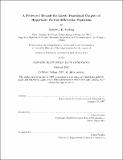A Posteriori Bounds for Linear Functional Outputs of Hyperbolic Partial Differential Equations
Author(s)
Vailong, Hubert J. B.
DownloadFDRL_TR-97-4.pdf (652.2Kb)
Metadata
Show full item recordAbstract
One of the major difficulties faced in the numerical resolution of the equations of physics is to decide on the right balance between computational cost and solutions accuracy, and to determine how solutions errors affect some given “outputs of interest.” This thesis presents a technique to generate upper and lower bounds for outputs of hyperbolic partial differential equations. The outputs of interest considered are linear functionals of the solutions of the equations. The method is based on the construction of an “augmented” Lagrangian, which includes a formulation of the output as a quadratic form to be minimized and the equilibrium equations as a constraint. The corresponding Lagrange multiplier, or adjoint , is determined by solving a problem involving the adjoint of the operator in the original equations. The bounds are then derived from the underlying unconstrained max-min problem. A predictor is also evaluated as the average value of the bounds. Because the resolution of the max-min problem implies the resolution of the original discrete equations, the adjoint on a fine grid is approximated by a hierarchical procedure that consists of the resolution of the problem on a coarser grid followed by an interpolation on the fine grid. The bounds derived from this approximation are then optimized by the choice of natural boundary conditions for the adjoint and by selecting the value of a stabilization parameter. The Hierarchical Bounds Method is illustrated on three cases. The first one is the convection-diffusion equation, where the bounds obtained are very sharp. The second one is a purely convective problem, discretized using a Taylor-Galerkin approach. The third case is based on the Euler equations for a nozzle flow, which can be reduced to a single nonlinear scalar continuous equation. The resulting discrete nonlinear system of equations is obtained by a Taylor-Galerkin method and is solved by the Newton-Raphson method. The problem is then linearized about the computed solution to obtain a linear system similar to the previous cases and produce the bounds. In a last chapter, the Domain Decomposition is introduced. The domain is decomposed into K subdomains and the problem is solved separately on each of them before continuity at the boundaries is imposed, allowing the computation of the bounds to be parallelized. Because the cost of sparse matrix inversion is of order O(N[third]), Domain Decomposition becomes very useful for two-dimensional problems,where the overall cost is divided by K[squared].
Date issued
1997-02Publisher
Aerospace Computational Design Laboratory, Dept. of Aeronautics & Astronautics, Massachusetts Institute of Technology
Series/Report no.
ACDL Technical Reports;FDRL TR-97-4